Stick with minor trends for now
In our view of 2006 we stated that
some of our favorite themes and sectors for the year include Korea,
Japan, Brazilian banks, Emerging Markets, South Africa, metals shares, energy
(particularly oil services), industrials, resources plays (watch for grains in
2006 perhaps), and China. So far the little that has developed of the year has
been quite good to these sectors. New highs are being made in Korea, Japan,
(
EEM |
Quote |
Chart |
News |
PowerRating),
(
EWZ |
Quote |
Chart |
News |
PowerRating), metals stocks, oil services, many resources, and China.
Back in August we highlighted
(
FXI |
Quote |
Chart |
News |
PowerRating) and Chinese markets in this column, and
I noted that I would like to be a buyer on a breakout above the August highs. It
has taken some time, but China is breaking out above those August highs now. The
Shanghai market has broken its downtrend line and broken out of a base, and
Chinese related shares look set to emerge on a possible new bull market. China
is already on our list of favorite sectors, but this certainly adds credence and
possible allocation to the theme.
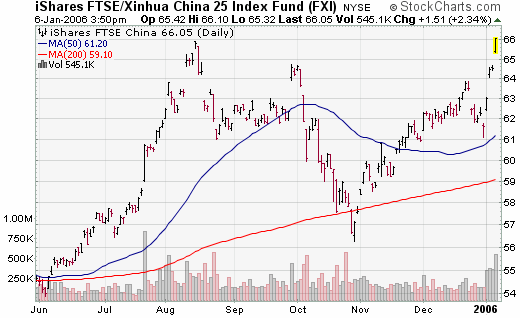
Our basic strategy of buying strictly only those stocks
meeting our rigid criteria and selling short those doing the same on breakouts,
had a mildly decent year in 2005 and beat the market with extremely low average
allocation. We suspect 2006 will be similar in that this is NOT likely to be the
environment where lots of such opportunities materialize.
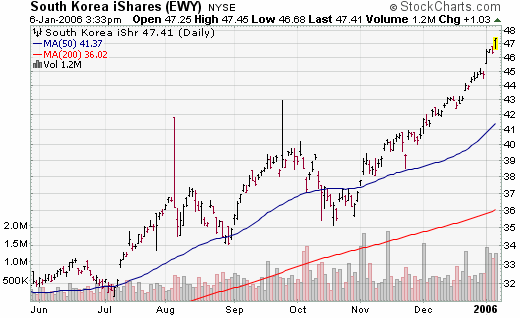
Our model portfolio followed in TradingMarkets.com with
specific entry/exit/ops levels from 1999 through May of 2003 was up 41% in 1999,
82% in 2000, 16.5% in 2001, 7.58% in 2002, and we stopped specific
recommendations up around 5% in May 2003 (strict following of our US only
methodologies should have had portfolios up 17% for the year 2003) — all on
worst drawdown of under 7%. This did not include our foreign stock
recommendations that had spectacular performance in 2003.
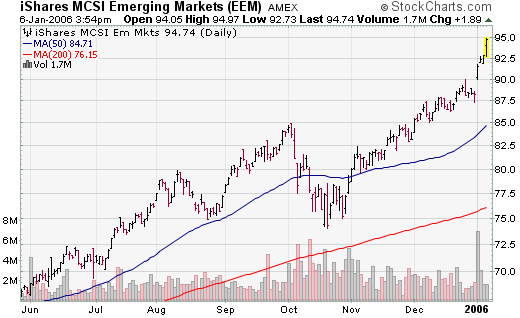
Over the past two weeks in our Top RS/EPS New Highs list
published on TradingMarkets.com, we had readings of 31, 13, 87, and 128 with 44
breakouts of 4+ week ranges, valid trades in
(
BOOM |
Quote |
Chart |
News |
PowerRating),
(
TKR |
Quote |
Chart |
News |
PowerRating), and
(
GG |
Quote |
Chart |
News |
PowerRating)
and close calls in
(
BRL |
Quote |
Chart |
News |
PowerRating),
(
NVDA |
Quote |
Chart |
News |
PowerRating), and
(
RTI |
Quote |
Chart |
News |
PowerRating). This week, our bottom
RS/EPS New Lows recorded readings of 17, 20, 22, and 5 with 6 breakdowns of 4+
week ranges, no valid trades and no close calls. The “model†portfolio of trades
meeting criteria is now long
(
TRAD |
Quote |
Chart |
News |
PowerRating),
(
CIB |
Quote |
Chart |
News |
PowerRating),
(
BOOM |
Quote |
Chart |
News |
PowerRating),
(
TKR |
Quote |
Chart |
News |
PowerRating), and
(
GG |
Quote |
Chart |
News |
PowerRating). The environment is getting a bit more positive and this is actually the
most biased and highest number of net longs via this strategy for some time.
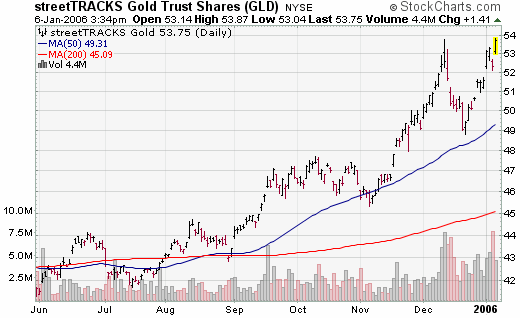
We continue to suggest milder than normal allocation to top
global themes, and for investors to expect volatility and less than optimum
markets. There ARE big risks. A dollar or Yen crisis, a US consumption or
housing crisis, or increases in Asian inflation are the primary concerns
investors should watch. However it appears more likely that these problems will
be mild and that markets will continue an irregular march higher to me at this
time. Therefore cautious exposure, trading in and out with minor trends, is
probably yet again the best approach to 2006.
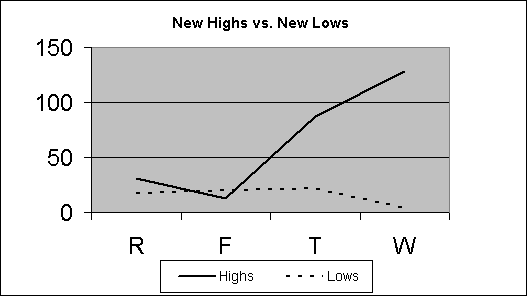
For those not familiar with our long/short strategies, we
suggest you review my book The Hedge Fund Edge. Basically, we have rigorous
criteria for potential long stocks that we call "up-fuel," as well as rigorous
criteria for potential short stocks that we call "down-fuel." Each day we review
the list of new highs on our "Top RS and EPS New High List" published on
TradingMarkets.com for breakouts of four-week or longer flags, or of valid
cup-and-handles of more than four weeks. Buy trades are taken only on valid
breakouts of stocks that also meet our up-fuel criteria. Shorts are similarly
taken only in stocks meeting our down-fuel criteria that have valid breakdowns
of four-plus-week flags or cup and handles on the downside. In the U.S. market,
continue to only buy or short stocks in leading or lagging industries according
to our group and sub-group new high and low lists. We continue to buy new long
signals and sell short new short signals until our portfolio is 100% long and
100% short (less aggressive investors stop at 50% long and 50% short). In early
March of 2000, we took half-profits on nearly all positions and lightened up
considerably as a sea of change in the new-economy/old-economy theme appeared to
be upon us. We’ve been effectively defensive ever since, and did not get to a
fully allocated long exposure even during the 2003 rally.
Mark Boucher
Mark Boucher has been ranked #1 by Nelson’s World’s Best
Money Managers for his 5-year compounded annual rate of return of 26.6%.
Boucher began trading at age 16. His trading helped finance his education at the
University of California at Berkeley, where he graduated with honors in
Economics. Upon graduation, he founded Investment Research Associates to finance
research on stock, bond, and currency trading systems. Boucher joined forces
with Fortunet, Inc. in 1986, where he developed models for hedging and trading
bonds, currencies, futures, and stocks. In 1989, the results of this research
were published in the Fortunet Trading Course. While with Fortunet, Boucher also
applied this research to designing institutional products, such as a hedging
model on over $1 billion of debt exposure for the treasurer of Mead, a Fortune
500 company.
